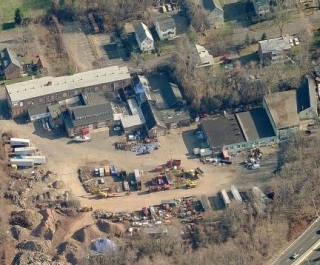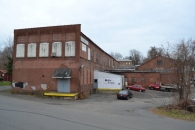Mill Record Middletown
RETURN TO ‘FIND MILLS’Disclaimer: Content for these properties was compiled in 2014-2017 from a variety of sources and is subject to change. Updates are occasionally made under Property Information, however the Connecticut Trust for Historic Preservation (dba Preservation Connecticut) makes no representation or warranty that the information is complete or up-to-date.
- Complex Name (Common)
- Omo Mfg. Co.
- Complex Name (Historic)
-
- Omo Mfg. Co.
- Address or Location
- 50 Walnut Street, Middletown
- County
- Middlesex
- Historic Designation
- Associated Mill Community

- Historic Information
Companies Associated w/Complex
- I.K. Penfield & Son ca. 1865-ca. 1871
- Middletown Rubber Works Co. 1893-1897
- Omo Manufacturing Co. 1897-ca. 1960
- Styles and Parker Press Co. ca. 1871-1893
Use (Historic)
Largest Documented Workforce
150-200 (1916)
Historic Narrative
The Omo Manufacturing Company was initially founded in 1893 as the Middletown Rubber Works Company. The primary organizer of the firm was Henry H. Francis, who was also a central figure at the Hartford Rubber Works Company in Hartford, Connecticut. Francis was elected as the first president of the Middletown Rubber Works and oversaw the purchase of the Walnut Street factory formerly held by the Stiles and Parker Press Company, which took over the plant from I.E. Penfield and Son for the production of drop hammers, presses, and dies around 1871. The Middletown Rubber Works Company initially produced a diverse line of rubber goods, including waterproof covers for baby diapers and dress shields, a cloth and rubber device sewn into the underarm area of dresses or shirts in order to protect the fabric from perspiration stains. Shortly after its release in 1896, the company’s synthetic rubber “Omo” dress shield was met with overwhelming popularity, resulting in the firm’s decision to change its name to the Omo Manufacturing Company and to abandon the manufacture of all but that item in an effort to keep up with demand. Despite this success, however, the company fell into receivership in 1897 following Francis’ abrupt departure from the firm the year before. The Omo Manufacturing Company was reorganized and incorporated early in 1898 with Francis returning as general manager. In 1899 he was appointed secretary and treasurer, and in 1900 again elected president of the company. Throughout this period and into the 1910s, advertisements for the rubber-free Omo dress shield proclaim its unobtrusive and odorless qualities, these being the key drivers of its success. In 1916, control of the thriving company was sold to Richter and Company, a Hartford brokerage house, by Alice S. Francis, the widow of Henry H. Francis, who had assume the role of president of the firm following her husband’s death in 1912. A Hartford Courant article announcing the transaction highlights the fact that the majority of the company’s 150-200 employees were women or girls, all of whom were well paid. The Courant simultaneously noted that many of the women received wages comparable to the men employed in other factories throughout Middletown, and that the firm was proud to have always employed only American-born labor. By the late-1910s, the Omo Manufacturing Company had expanded both its plant and product line, the latter then including an array of rubber products including rubber webbing and odorless waterproof sheeting for hospitals. The company continued to operate into the 1960s, whereupon it was acquired by Georgia Bonded Fibers, which produced fabric-bonded fiberboard luggage. In 1970, this was bought out by Hildebrand Industries, a producer of chemically-coated fabrics used in the production of automobiles, clothing, footwear, luggage, and upholstery.
- Architectural Information
Number of Existing Buildings
Roughly nine (9) primary blocks.
Dates of Construction
ca. 1865, ca. 1870, ca. 1880, 1889, ca. 1905, ca. 1920, ca. 1950, ca. 1960
Architect
n/a
Builder
n/a
Building Type
Architectural Description
The former Omo Manufacturing Company factory complex consists of two clusters of adjoining buildings located at the southwest corner of the intersection of Walnut Street and River Road. The first group served as the manufacturing plant and is comprised of an adjoining group of five identifiable blocks built between ca. 1865 and ca. 1960. The second cluster served as warehouse space and includes four one-story blocks erected between ca. 1920 and ca. 1960 located to the southwest of the factory buildings. The blocks comprising the manufacturing section of the plant consist of a mix of one-, one-and-a-half-, and two-story blocks with red brick walls and flat or gable roofs. One of the earliest is a two-story foundry building (this used for storage by the Omo Manufacturing Co.) located at the northwest corner of the plant. This was built ca. 1880 and measures 82’ x 54’. It has segmental-arched window openings, a brick cornice with cornice returns, front-gabled roof, and a shed-roof monitor on its western elevation. The foundry is connected to a long two-story block running north-south along Walnut Street by various one-story brick blocks erected throughout the early-to-mid 20th century. The two-story block lining Walnut Street was originally built as two one-story buildings ca. 1880 and 1889. These were raised to two stories in height around 1905. The resultant building, used for finishing, sewing, and packing, appears as a singular, 46’ x 226’ red brick block and has segmental-arched window openings, paired four-over-four or six-over-six double-hung wood sash, brick cornice, and flat roof. The façade is capped by a corbelled brick parapet with tile coping, and a two-story, 18’ x 52’ red brick office block with denticulated water table and cornice is located adjoining its southeast corner. Remaining blocks throughout the complex include areas formerly used at various times for the milling, curing, drying, cutting, vulcanizing, compounding, coating, painting, and storage of rubber products.
Exterior Material(s)
Structural System(s)
Roof Form
Roof Material
Power Source
Condition
Fair, Deteriorated
Condition Notes
The building is in generally fair condition. Sections of the exterior walls are deteriorated or have been sloppily repointed. A number of the original window openings have been partially infilled or the historic sash replaced.
- Property Information
-
Specific Location
One legal parcel (50 Walnut Street) totaling 6.67 acres at the southwest corner of the intersection of Walnut Street and River Road.
Adjacent To
Exterior Visible from Public Road?
Yes
Parcel ID / Assessor Record Link
- 33/ / 0070 / Link →
Acreage
6.67
Use (Present)
- Sources
-
Form Completed By
Lucas A. Karmazinas
Date
11/25/2014
Bibliography
- List of Connecticut Manufacturers, 1922, 1924, 1930, 1932.
- Directory of Connecticut State Manufacturers, 1936, 1939.
- Atlas of Middlesex County, F.W. Beers & Co., 1874.
- Middletown Bird’s Eye View, 1877, 1915.
- Industrial Directory of Connecticut, 1947.
- Register of War Production Facilities in Connecticut, 1951.
- Sanborn Map Company, 1889, 1895, 1901, 1913, 1924, 1950.
- Aerial Survey of Connecticut, 1934, 1965.
- Middletown City Directory, 1887-1960.
- History of Middlesex County, Connecticut, 1884.
- The Hartford Courant, 1916, 1998.
- Representative View(s)Click on image to view full file









